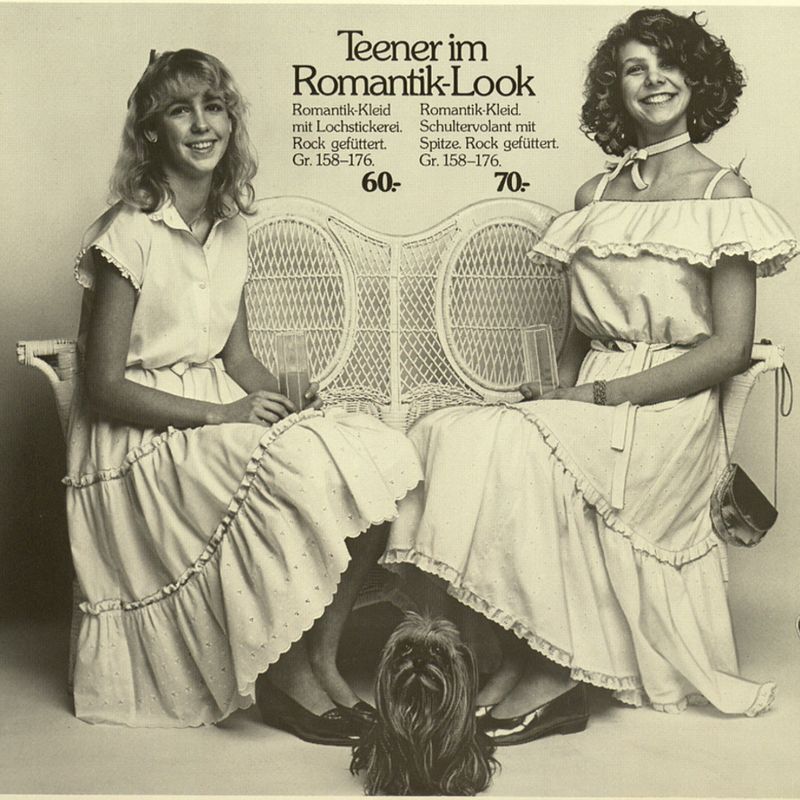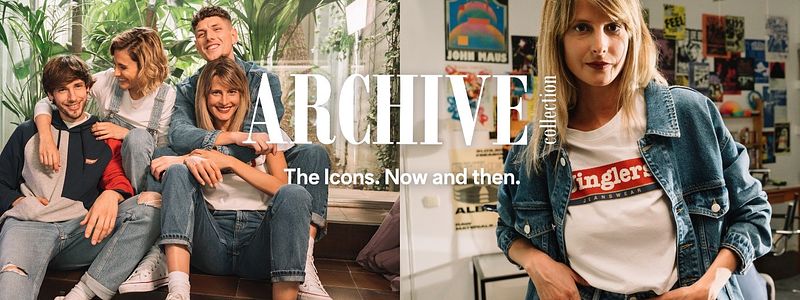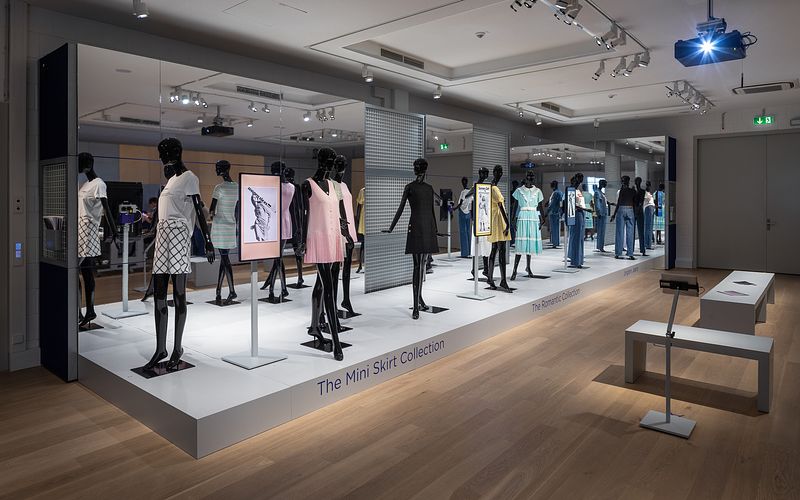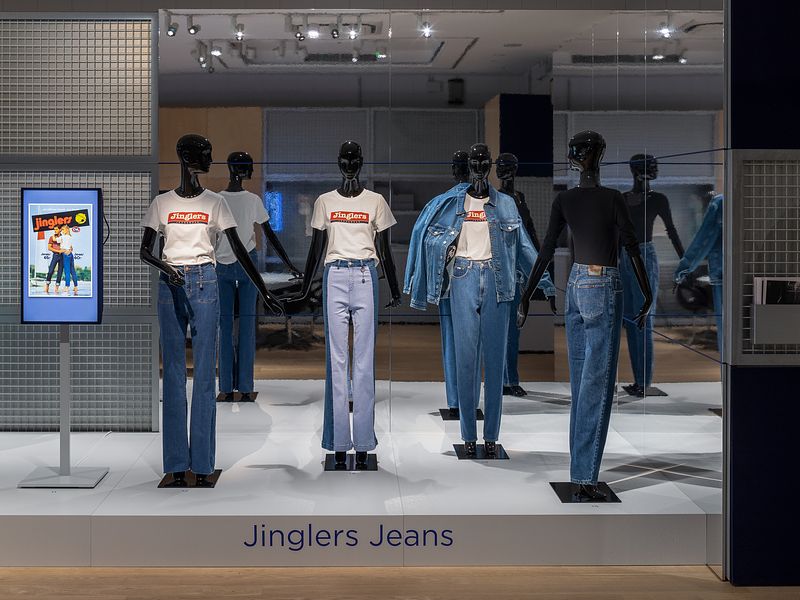15.08.2022
Interview: The Archive Collection
How did the Archive Collection come about?
Amanda Tiran

How did you combine the styles from the past with the current trends? I believe you can’t translate them one to one.
Amanda Tiran
.png?locale=en)
What was the actual work process like?
Jens Brokfeld

What are your favourite pieces created in this collection?
Amanda Tiran
Oh gosh, I have a couple. So we did a coats collection and there’s a really beautiful one in there. Is it a green trench? Actually, I think that we got inspiration from the 1940s sketches. I’m trying to think back into the archive now. We did this kind of khaki green trench, that is one of my favourites.

Amanda Tiran, United Leader Product Manager - Mindset-Team - C&A Buying GmbH & Co.KG
Reinhard Brodel, Stylist Clockhouse - C&A Buying GmbH & Co.KG
Jens Brokfeld, Archivist, Draiflessen Collection
Dr. Maria Spitz, Curator for Fashion and Textile, Draiflessen Collection
Dr. Julia Cwojdzinski, Collection Management, Draiflessen Collection
***You can find the interview in printed form in our OPEN UP! THE ARCHIVE COLLECTION.
Click here to go to our shop.
Interview: The Archive Collection
This interview was published in our OPEN UP! THE ARCHIVE COLLECTION and describes the cooperation between C&A and our colleagues from the archive and collection of the Draiflessen Collection.
How It All Began
How did the Archive Collection come about?
Amanda Tiran
I can give an overview of how it all began. It was back in 2020 in November when we brainstormed at C&A about a vintage collection. We wanted to do something for the 180th anniversary of the company in 2021. We were taking a trip down memory lane and someone came up with his first ski suit from C&A. These were very popular especially back in the 1980s ...
Reinhard Brodel
Reinhard Brodel
…and then we thought of all the memorable adverts that were produced for all kinds of clothing. A colleague connected us to the team at Draiflessen because of their robust collection of archival C&A materials.
Jens Brokfeld
Jens Brokfeld
We were excited about the project to bring our historical adverts and the textile collection back to life. So we arranged online meetings to discuss what Amanda and Reinhard were looking for and what we could offer from our holdings.
Maria Spitz
Maria Spitz
The most important sources we used for this project were advertising folders originally created by the C&A advertising division, the historical commercials, and the fashion collection. In 2006 we started the heritage project. Luckily, many exciting pieces from the past, such as the advertising folders, have survived. And since then, we have been working systematically on building up the collection of historical clothing, especially from C&A, and very current fashion. Our focus lies not only on women’s clothing, but on clothing for the whole family. That is what makes this collection so special.
Julia Cwojdzinski
Julia Cwojdzinski
We currently have a total of almost 4,000 garments and accessories. Our collection of advertising folders contains print advertisements from 1911 until 2002. By browsing through you can feel the different times, the different decades.
Did the design team already have a fixed idea about what materials they wanted to see?
Amanda Tiran
Not really, no. In the beginning we collected all kinds of information. We went to vintage stores and also found a lot of information of past C&A styles on the web. We thought about bringing out about thirty collections but in the course of events we narrowed it down to five topics.
Reinhard Brodel
We also tried to capture the current vibe. We saw a lot of denim on the streets and wanted to create something that combines inspiration from the past with a modern look.
Jens Brokfeld
The design team went on to create mood boards which showed the styles, colours, and materials they wanted to emphasize. This helped us to know what to look for in the collection.
Did the design team already have a fixed idea about what materials they wanted to see?
Amanda Tiran
Not really, no. In the beginning we collected all kinds of information. We went to vintage stores and also found a lot of information of past C&A styles on the web. We thought about bringing out about thirty collections but in the course of events we narrowed it down to five topics.
Reinhard Brodel
We also tried to capture the current vibe. We saw a lot of denim on the streets and wanted to create something that combines inspiration from the past with a modern look.
Jens Brokfeld
The design team went on to create mood boards which showed the styles, colours, and materials they wanted to emphasize. This helped us to know what to look for in the collection.
In a project like this one, the visual inspection of advertisements and fashion items was of major importance. The design team from C&A did not want to recreate a specific decade in detail but was looking for inspiration across boundaries to create something new.
Generally, however, researching a curated collection can be quite specific and is conducted with help of so-called metadata. This is information about an item, like its origin, the time it was created, or keywords to describe it. Thus, we can narrow down the amount of material we need to sift through.
The more we know about the context of an object, the better our search results will be. Written documents often give valuable clues by themselves: for example, the dates on an advertisement.
Julia Cwojdzinski
This is somewhat different in the field of historic fashion. To find out more about a garment, especially when the label is missing or was removed by the previous owner, you have to “read” the object, the material, the cut, the style and align this information with other sources such as advertisements or photos. Luckily, in Draiflessen we have all the information in one database. Thanks to this we were able to work on this exciting project even in times of Covid.
The more we know about the context of an object, the better our search results will be. Written documents often give valuable clues by themselves: for example, the dates on an advertisement.
Julia Cwojdzinski
This is somewhat different in the field of historic fashion. To find out more about a garment, especially when the label is missing or was removed by the previous owner, you have to “read” the object, the material, the cut, the style and align this information with other sources such as advertisements or photos. Luckily, in Draiflessen we have all the information in one database. Thanks to this we were able to work on this exciting project even in times of Covid.
The label is very important because it allows you to recognise not only the brand but also the roundabout time of production. This is because we know the specific look of the labels in certain decades.
Maria Spitz
Maria Spitz
By the way, labelling C&A clothes only started as late as the 1930s with the brand formtreu (true-to-form). The characteristic feature of formtreu coats and jackets was the springy padding with horsehair which ensured a good fit and would keep its shape very well. It was hugely popular and it remains a well-known brand for its time.

"Teenanger im Romatik-Look", C&A Werbeanzeige, 1981
| © Draiflessen Collection
Styles: Linear or Cyclical?
How did you combine the styles from the past with the current trends? I believe you can’t translate them one to one.
Amanda Tiran
It really depends. Some topics we actually translated very similarly. And for others we made subtle adaptions. Take the flare leg or bell bottom, for example. This was very popular in the 1970s. We still do it but it’s just a little narrower nowadays. This makes it more modern for today. We are seeing a resurgence of styles from the 1960s, 1970s, 1980s on the market. Y2K is also big at the moment.
Reinhard Brodel
Reinhard Brodel
One might ask whether fashion is cyclical or linear but I would say it’s both because I think it never comes back one to one as it used to be, and I think we are improving a lot in how fabrics are developed. You know, it’s very innovative to have really new fabrics which are more comfortable.
Do you feel that the iconic styles from the past are fading away because everybody creates their own personal styles? And what does this mean for a fashion collection?
Reinhard Brodel
Do you feel that the iconic styles from the past are fading away because everybody creates their own personal styles? And what does this mean for a fashion collection?
Reinhard Brodel
I think an interesting aspect here is that nowadays a lot of things are running parallel while in the past we often had the feeling that fashion was dictated. You know, you had a certain style for a certain moment, or even for a longer time, but nowadays you feel there’s a lot of things going on and quite a lot is really up to your personal style. So everybody really takes out what is best for them.
I would say this started with the new millennium. Maybe even a little bit earlier in the 1990s. I feel definitely in the 1950s to 1980s there were a lot of dictates. Yeah, because if there was a miniskirt or minidress you had no chance but to wear it. Whether you had the right legs for it or not.
Amanda Tiran
I even think within the last ten years, you know, as influencers have become such a big topic and a key part of marketing strategies, I feel that’s really where personal style started to come into play and now you can go shopping on high street, at different retailers, and you can see things pulled from all different kinds of decades. It’s not just one thing, sometimes it’s a capsule collection that looks very 1970s, and then you see another capsule collection where they’ve pulled the blouson of the 1980s. So yeah, like Reinhard said, I think it’s very liberal nowadays.
Maria Spitz
Yes, it is. I am looking for the most iconic pieces for our collection. Clothing and accessories are perhaps most suitable to bring a feeling of a period back. And – I am sure – this will also be possible with the individual styles nowadays, because there surely is something which remains typical for today or tomorrow. It is the combination of hairstyles, make-up, clothing, and how the pieces were worn and combined. So it is, from my point of view, not enough to collect single pieces for a fashion collection but “styles” with pieces that embody the zeitgeist, so that fashion historians of the next generation will find the iconic pieces they are looking for in the collection of Draiflessen.
Amanda Tiran
I even think within the last ten years, you know, as influencers have become such a big topic and a key part of marketing strategies, I feel that’s really where personal style started to come into play and now you can go shopping on high street, at different retailers, and you can see things pulled from all different kinds of decades. It’s not just one thing, sometimes it’s a capsule collection that looks very 1970s, and then you see another capsule collection where they’ve pulled the blouson of the 1980s. So yeah, like Reinhard said, I think it’s very liberal nowadays.
Maria Spitz
Yes, it is. I am looking for the most iconic pieces for our collection. Clothing and accessories are perhaps most suitable to bring a feeling of a period back. And – I am sure – this will also be possible with the individual styles nowadays, because there surely is something which remains typical for today or tomorrow. It is the combination of hairstyles, make-up, clothing, and how the pieces were worn and combined. So it is, from my point of view, not enough to collect single pieces for a fashion collection but “styles” with pieces that embody the zeitgeist, so that fashion historians of the next generation will find the iconic pieces they are looking for in the collection of Draiflessen.
.png?locale=en)
The Archive Collection, C&A
| © Zissou
The Cooperation
What was the actual work process like?
Jens Brokfeld
Everybody works differently depending on their professional background. In an archive and in a museum collection it is important to have a good structure, to make clear distinctions and to be organized. But at some point you want to create something new and this is where you have to make a leap in a way. Imagination is needed to appreciate what potential lies dormant in the archives …
Maria Spitz
Maria Spitz
… and then you start thinking about research projects and exhibitions.
Reinhard Brodel
Reinhard Brodel
It’s interesting what you say about being structured and organized. Design often means chaos in the beginning. Yeah, it’s really like this because we have a lot of ideas, a lot of things on the table. But nevertheless at a certain moment you have to narrow it down and you have to come up with a plan with a range of players. Therefore we do have different people in a team. And all together, you can create something nice and special then.
Jens Brokfeld
Jens Brokfeld
Talking about cooperation, I think that the way in which we work in projects like this has changed quite a bit in times of Covid. All our meetings naturally took place online and much of the research into our archives was carried out remotely on the computer. Luckily, the majority of historical advertisements had been digitized already. Working with electronic data has many advantages, although it cannot replace the originals. Indeed, the prevalence of digital images seems to me to reinforce the appreciation of the value inherent in the physical artifacts, that is of material properties of textiles and paper as well as their aura of authenticity.

Ausstellungsansicht THE ARCHIVE COLLECTION
| © Draiflessen Collection, Foto: Henning Rogge
Favourite Pieces
What are your favourite pieces created in this collection?
Amanda Tiran
Oh gosh, I have a couple. So we did a coats collection and there’s a really beautiful one in there. Is it a green trench? Actually, I think that we got inspiration from the 1940s sketches. I’m trying to think back into the archive now. We did this kind of khaki green trench, that is one of my favourites.
And then I also love the jumpsuit. This kind of black denim acid-washed jumpsuit that we did for Jinglers Denim.
Reinhard Brodel
Reinhard Brodel
My favourite piece is currently in the mail. I’m waiting for this. It is this wonderful dark blue ski overall for men.
Maria Spitz
Maria Spitz
Yeah, for me especially the red ski overall which is so 1970s is fantastic – my favourite piece for women. And for men I like the checked double-breasted coat most. It is very formtreu.
Julia Cwojdzinski
Julia Cwojdzinski
I have a favourite piece I even bought for myself, a jacket from the Archive Jinglers collection. It was obviously inspired by the 1980s with its wide shoulders, the waisted cut, and the isometric zipper but looks very modern too – a hip jacket from nowadays. I had to buy it. The black version actually. For me it is a perfect example how the designers combined an iconic style from the past with a fresh idea to create something new and trendy.
Jens Brokfeld
Jens Brokfeld
I like the more classic styles. It is great to see how they never go out of fashion. The overcoats from the Archive Collection for example … The continuity of their style is highly visible and yet the designers have added a new touch to them. That would be something for me.

Ausstellungsansicht THE ARCHIVE COLLECTION
| © Draiflessen Collection, Foto: Henning Rogge
Amanda Tiran, United Leader Product Manager - Mindset-Team - C&A Buying GmbH & Co.KG
Reinhard Brodel, Stylist Clockhouse - C&A Buying GmbH & Co.KG
Jens Brokfeld, Archivist, Draiflessen Collection
Dr. Maria Spitz, Curator for Fashion and Textile, Draiflessen Collection
Dr. Julia Cwojdzinski, Collection Management, Draiflessen Collection
***You can find the interview in printed form in our OPEN UP! THE ARCHIVE COLLECTION.
Click here to go to our shop.